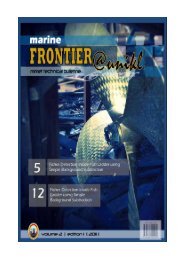click here to download - UniKL MIMET Official Website
click here to download - UniKL MIMET Official Website
click here to download - UniKL MIMET Official Website
You also want an ePaper? Increase the reach of your titles
YUMPU automatically turns print PDFs into web optimized ePapers that Google loves.
Since chemical products have high pu‐<br />
rity and corrosiveness, corrosion protection and<br />
prevention is very important. The popular types<br />
of chemical tanker plate material is made from<br />
special types of stainless steel with a high resis‐<br />
tant <strong>to</strong> corrosion from acid. Stainless steel used<br />
for bulkheads can be solid stainless steel or mild<br />
steel clad with stainless steel. Rubber is some‐<br />
times used <strong>to</strong> line tanks carrying products<br />
mainly acids, which are unsuitable for use with<br />
stainless steel or coating. Zinc silicate is fre‐<br />
quently used in tanks designed <strong>to</strong> carry alcohol<br />
as well as some types of solvents and other<br />
chemicals. It is necessary <strong>to</strong> inspect zinc coated<br />
bulkhead after they have been dried <strong>to</strong> ensure<br />
the coating has not been softened or otherwise<br />
damaged.<br />
The requirement for coating application<br />
is under MARPOL Annex II (Regulations for the<br />
Control of Pollution by Noxious Liquid Sub‐<br />
stances). Before coating application, the steel<br />
temperature and relative air humidity in the tank<br />
are two basic fac<strong>to</strong>rs <strong>to</strong> observe in ensuring the<br />
correct coating application. The application of<br />
coating starts from the bot<strong>to</strong>m of the tank <strong>to</strong> the<br />
ceiling, because during application the evapo‐<br />
rated solvents may flow <strong>to</strong> the bot<strong>to</strong>m of the<br />
tank. Hence, the air in the tank is both renewed<br />
and dehumidified <strong>to</strong> keep clean atmosp<strong>here</strong> and<br />
steady temperature and humidity conditions.<br />
Figure 2: Application of coating<br />
<strong>MIMET</strong> Technical Bulletin Volume 1 (2) 2010<br />
The sequence of coating application also plays an<br />
important rule. If we consider a coating system of<br />
two parts (2 coatings), then we should apply the<br />
first coating <strong>to</strong> all tank surfaces for a specific dry<br />
film thickness. At this stage, as we approach the<br />
ceiling we must cover the tank bot<strong>to</strong>m <strong>to</strong> avoid any<br />
overspray.<br />
Figure 3: Coating application sequence<br />
Some cargoes are required <strong>to</strong> be carried at<br />
certain temperatures. For that reason, heating coils<br />
are installed in the cargo tanks <strong>to</strong> keep the cargo at<br />
the required temperature. The heating substance is<br />
oil or water coming from a heat exchanger, so en‐<br />
able the cargo <strong>to</strong> be carried at a desired range of<br />
temperatures (ExxonMobil, 2002). Chemical tankers<br />
must have a system for tank heating in order <strong>to</strong><br />
maintain the viscosity of certain cargoes. Typically<br />
this system consists of a boiler which pumps pres‐<br />
surized steam through so‐called “heating coils”<br />
made from stainless steel pipes in the cargo tanks,<br />
thus transferring heat in<strong>to</strong> the cargo, which circu‐<br />
lates in the tank by convection.<br />
In SOLAS Chapter II‐2, Regulation 4 Para‐<br />
graph 5.5, tankers are also required <strong>to</strong> be fitted with<br />
an inert gas system. With the inert gas system, the<br />
protection against a tank explosion is achieved by<br />
keeping the oxygen content low. It will reduce the<br />
hydrocarbon gas concentration of tank atmosp<strong>here</strong><br />
<strong>to</strong> a safe proportion. The problem is that impurities<br />
such as carbon and moisture are normally present<br />
in flue gases and it is difficult <strong>to</strong> use a conventional<br />
inert gas system with some chemical.<br />
| MARINE FRONTIER @ <strong>UniKL</strong><br />
115



